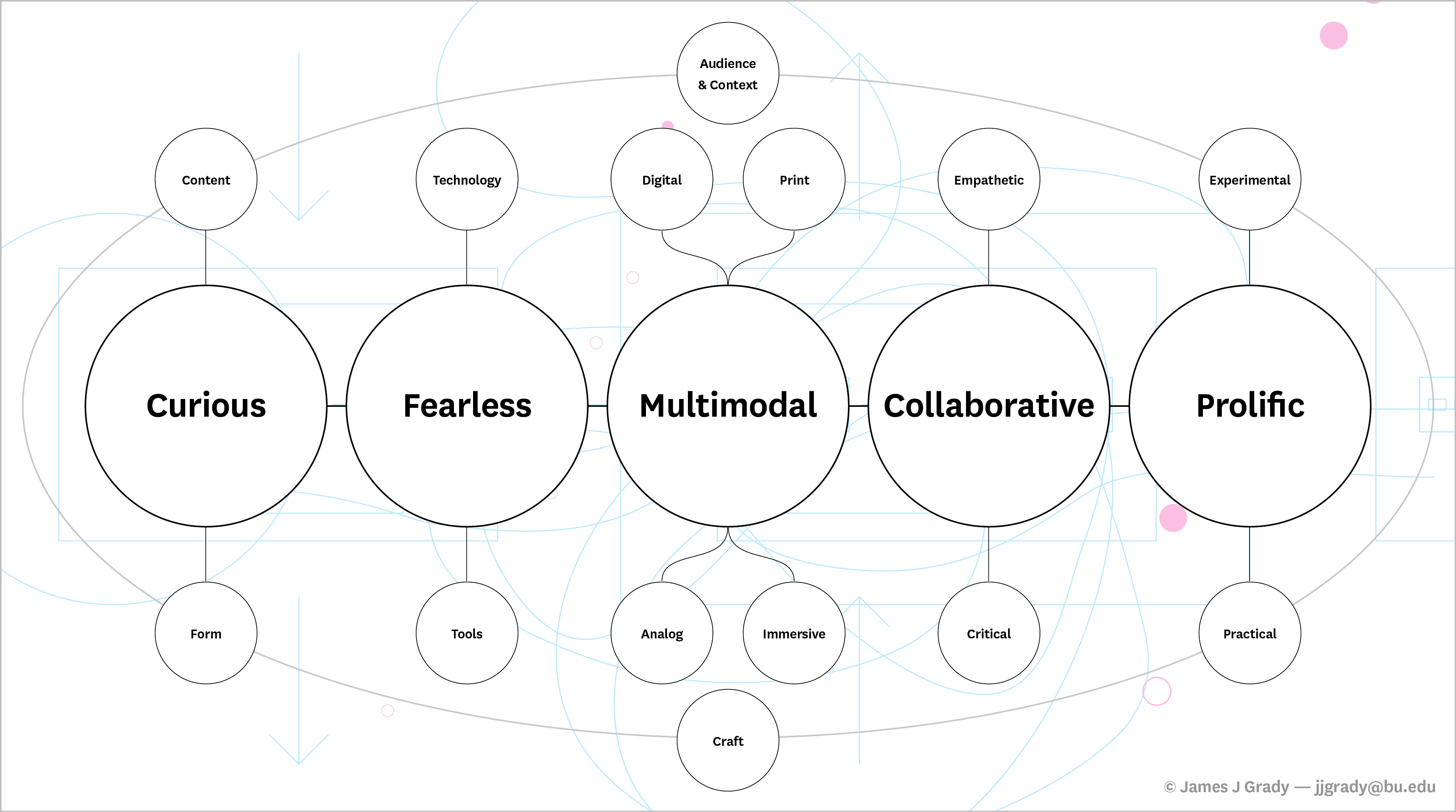Philosophy
My teaching philosophy centers on three core principles: Audience, Context, and Craft. These principles form the foundation of my approach as an educator, shaping how I prepare students for the evolving demands of the design field. By fostering curiosity, fearlessness, multimodal exploration, collaboration, prolific experimentation, and an iterative mindset, I aim to cultivate designers who are adaptable, thoughtful, and prepared to shape the future.Core Principles:
- Audience: Design is about understanding who you’re designing for and the purpose of the product. This ensures the design resonates and achieves its goal.
- Context: Design exists within a specific medium or platform, whether print, screen, or immersive experience. This context shapes how the message is received.
- Craft: Design requires obsessive attention to detail, precision, and a commitment to high-quality execution.

Expectations for My Students
I hold my students to a set of guiding expectations that encourage deep engagement with their work:
-
Be Curious: Explore both content and form with wonder and inquiry. Curiosity fuels discovery and leads to unexpected insights.
-
Be Fearless: Embrace tools and technology without hesitation. Whether learning new software or experimenting with unconventional techniques, stepping outside one’s comfort zone drives growth.
-
Be Multimodal: Design today isn’t confined to one medium. Students should feel comfortable moving fluidly between print, digital, and immersive formats, integrating these seamlessly into their practice.
-
Be Collaborative: Foster empathy and constructive critique. Learning from peers, offering meaningful feedback, and working as part of a team are essential skills in a collaborative world.
-
Be Prolific: Produce boldly and often. Experimentation sparks innovation, but always consider the audience’s perspective during the process.
-
Reflect & Refine: Continuous iteration and improvement lie at the heart of successful design. Embracing feedback and refining ideas is a hallmark of a skilled designer.
Design as a Future-Focused Discipline
My teaching philosophy embraces the ever-changing landscape of design, preparing students for dynamic roles as interdisciplinary creators in society. While my experiences inform my perspective, I focus on guiding students in imagining and building their future within the field.
Inspiration surrounds us, often hidden in plain sight. Overlooked moments, mundane details, or personal experiences can serve as catalysts for profound creativity. I encourage students to observe their immediate environments closely, mining them for formal and conceptual insights. This practice strengthens their critical thinking and problem-solving skills while also fostering a habit of recognizing design opportunities everywhere.
Balancing the Technical and the Conceptual
In today’s world of design, integrating multiple media is non-negotiable. My goal is to ensure students gain proficiency in technical skills and contemporary tools, while grounding this knowledge in the historical and theoretical contexts of graphic design and typography. Dynamic media, in particular, is a dominant force in the field, and I encourage students to approach it with both technical competence and conceptual depth.
However, technical mastery is just part of the equation. My ultimate aim is to help students discover their unique creative voices. By exposing them to diverse disciplines and systems of output, I encourage them to challenge traditional boundaries and explore innovative ideas. This freedom to experiment helps them grow into designers confident in their individuality and capable of contributing original perspectives to collaborative projects.
Collaboration and Critique
Collaboration is central to graphic design, which is more of a shared experience today than ever before. I emphasize the importance of working with others—not just in execution but in idea generation and critique. Learning how to give and receive constructive feedback is a vital skill that students can carry into any professional or personal setting.
Critique plays a key role in my teaching. I encourage students to embrace feedback as an opportunity to refine and elevate their work. The process of reflection and iteration is something designers must engage with throughout their careers, and I aim to instill this mindset early.
Teaching as a Reciprocal Experience
Teaching is not a one-way street. I value the opportunity to learn from my students, whose fresh perspectives and fearless creativity inspire me to stay curious and adaptable. Watching them grow as designers and problem-solvers—and ultimately apply their skills in the world—is one of the most rewarding parts of my work.
My philosophy focuses on preparing students for the future by exploring new directions in design pedagogy that extend beyond traditional frameworks. By fostering an environment of exploration, experimentation, and collaboration, I aim to equip students with the tools and mindset needed to navigate the ever-evolving design landscape. Whether they go on to create groundbreaking visual systems, address societal challenges through design, or lead in emerging industries, I want my students to approach their roles with confidence, curiosity, and a deep understanding of their power to make a meaningful impact.
With this philosophy as my guide, I hope to inspire students to embrace the exciting possibilities and challenges ahead, ensuring they are not only participants but leaders in shaping what is to come.
View James’ CV ↗︎